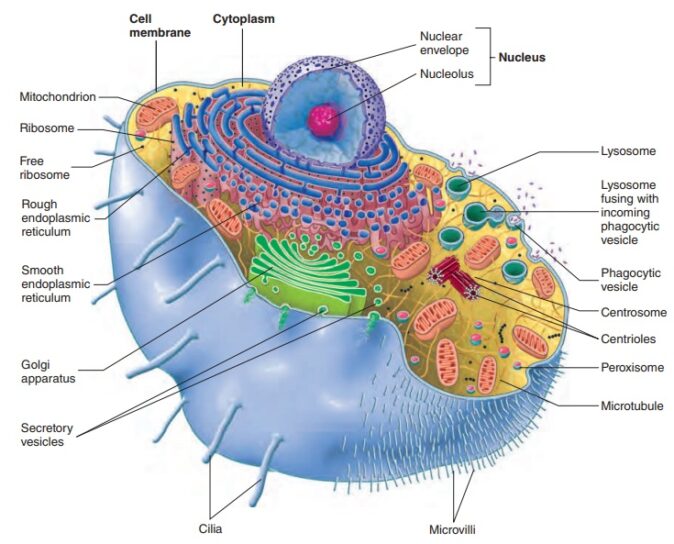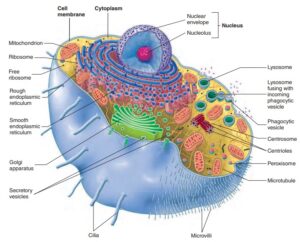Living Organisms (JAMB Note)

Living organisms is an essential topic in Biology for JAMB candidates. It is the first topic in JAMB Syllaabus for Biology.
As I observe the natural world, I am fascinated by the diverse living organisms and their remarkable qualities of growth, metabolism, reproduction, sensitivity and adaptation that distinguish them from non-living entities. I know these complex abilities arise from intricate biochemical processes occurring within highly organized structures in living systems.
In this JAMB Biology note on Living Organism, I will teach about living organisms, explain how they exhibit a hierarchical organization. At the basic level, I will describe how they are made up of cells – the fundamental units of structure and function
- Characteristics of living organisms
- Cell Structure and Their Functions
- Levels of organization
- Levels of Organization of Euglena and Paramecium
- Levels of Organization Tissue of Epithelial tissue and Hydra
- Levels of Organization of Organ – Onion bulb
- Systems – Reproductive, digestive and excretory
- Organisms – Chlamydomonas
- Types of Cell
- Examples of Organisms:
Characteristics of living organisms
Living organisms share certain common characteristics that distinguish them from non-living things. These include:
- Growth and development – Living things grow in size and undergo developmental changes throughout their life cycle.
- Reproduction – Living organisms are capable of reproducing to create new individuals of the same species. This occurs through sexual or asexual reproduction.
- Movement – Most living things exhibit some form of movement at some point during their lives, whether it is moving their entire body from one place to another or moving internal components.
- Respiration – Living organisms undergo respiration to obtain energy from food. This involves taking in oxygen and releasing carbon dioxide.
- Sensitivity – Living things are able to detect and respond to changes in their environment through use of sensory organs and nervous coordination.
- Nutrition – Living organisms require nutrition in the form of food and water for growth, repair and functioning. They break down nutrients through digestion.
- Excretion – The removal of metabolic waste from the body is done through excretion.
- Adaptation – Living organisms are adapted to survive in their native environment through morphological, physiological and behavioral adaptations.
Cell Structure and Their Functions

The cell is the basic structural and functional unit of life. Cell structure and components enable it to perform all the essential functions of life.
- Cell membrane – Forms the outer boundary of the cell and regulates the movement of substances in and out of the cell. It is selectively permeable.
- Cytoplasm – Jelly-like substance inside the cell containing organelles and site for many metabolic reactions.
- Nucleus – Control center of the cell containing genetic material chromosomes made up of DNA molecules.
- Mitochondria – Powerhouses of the cell involved in cellular respiration to produce energy rich ATP molecules.
- Ribosomes – Small structures where protein synthesis takes place.
- Endoplasmic reticulum – Network of membranous tubules for synthesis, processing and transport of proteins.
- Golgi apparatus – Packages and distributes proteins synthesized by the cell.
- Lysosomes – Contain digestive enzymes for breaking down worn-out cell components, food particles and foreign microbes.
- Vacuole – Fluid-filled sac that stores nutrients, removes waste and maintains internal hydrostatic pressure.
Levels of organization
Living organisms show a hierarchical pattern of organization with increasing complexity:
- Cells: Basic units of life made up of organelles performing specialized functions. Unicellular organisms like bacteria consist of a single cell.
- Tissues: Group of similar cells performing a common function. Various types include epithelial, connective, muscular and nervous tissues.
- Organs: Comprise of different tissues working together to perform specific functions. Examples are heart, lungs, kidney etc.
- Organ systems: Interconnected organs carrying out coordinated functions. Examples are digestive system, circulatory system, reproductive system.
- Organisms: The highest level of organization. Multicellular organisms contain organ systems that work together to sustain life.
Levels of Organization of Euglena and Paramecium
- Euglena is a unicellular protist that has features of both plant and animal cells. It has chloroplasts to prepare food through photosynthesis. An eyespot detects light.
- Paramecium is a unicellular ciliate protozoan. It has cilia all over its body for locomotion and feeding. A macronucleus controls cellular activities.
Levels of Organization Tissue of Epithelial tissue and Hydra
- Epithelial tissue consists of closely packed cells with little intercellular matrix. Forms covering and lining of organs and body cavities. Allows selective transport across body surfaces.
- Hydra is made up of two tissue layers – epidermis (outer layer) and gastrodermis (inner layer). Epidermis provides protection while gastrodermis lines the digestive cavity.
Levels of Organization of Organ – Onion bulb
- Onion bulb consists of modified leaves that function as storage organs, storing carbohydrate nutrients.
- The leaves, stems and roots of the bulb also serve as organs carrying out specialized functions.
Systems – Reproductive, digestive and excretory
- Reproductive system consists of sex organs and glands for the function of reproduction. Main organs are testes and penis in males, ovaries, uterus and vagina in females.
- Digestive system is made of organs like mouth, oesophagus, stomach, intestines, liver etc. that together digest food, absorb nutrients and eliminate undigested waste.
- Excretory system removes metabolic wastes and maintains fluid and electrolyte balance. Kidneys, ureters, urinary bladder and urethra are the main constituent organs.
Organisms – Chlamydomonas
- Chlamydomonas is a unicellular green alga. All life processes like nutrition, reproduction, excretion happen within its single cell.
- It has chloroplasts for photosynthesis, eyespot to detect light, flagella for locomotion and a defined wall for support and shape.
Types of Cell
There are two main types of cells based on the presence or absence of a nucleus:
Prokaryotic Cells:
- Lack a nucleus and membrane-bound organelles.Examples are bacteria and cyanobacteria
- Have cell wall composed of peptidoglycan
- Genetic material in the form of a single circular DNA exists freely in the cytoplasm
- Ribosomes are smaller than eukaryotic cells
Examples: E.coli, Bacillus, Streptococcus
Eukaryotic Cells
- Have a well-defined nucleus enclosed by a nuclear membrane
- DNA is organized into chromosomes contained within the nucleus
- Membrane-bound organelles like mitochondria, ER, lysosomes, Golgi complex are present
- Larger ribosomes compared to prokaryotes
- Examples: Protozoa, fungi, plant and animal cells
Types of eukaryotic cells
- Plant cells – Have cellulose cell walls, plastids, large central vacuole
- Animal cells – Lack cell wall, plastids and large vacuoles
- Fungal cells – Have cell walls made of chitin, storage polysaccharide is glycogen
- Protozoan cells – Unicellular eukaryotic organisms like Amoeba, Paramecium
Examples of Cells
- Euglena is a unicellular protist with features of both plant and animal cells. It has chloroplasts to make food by photosynthesis. It also has an eyespot to sense light and a flagellum for locomotion.
- Paramecium is a unicellular ciliate protozoan. Its cell surface has thousands of cilia to help it move and feed. It also has a macronucleus for controlling cellular activities and micronuclei involved in reproduction.
Examples of Tissues
- Epithelial tissues line body surfaces and cavities and form the outer layer of organs. The cells are closely packed with little intercellular matrix. They provide protection, secretion, absorption and selective exchange.
- Hydra is a simple freshwater invertebrate made up of two tissue layers – outer epidermis and inner gastrodermis, with a non-cellular mesoglea between them. The epidermis provides protection while gastrodermis lines the digestive cavity.
Examples of Organs
- Onion bulbs are underground part of the onion plant used for food storage and vegetative reproduction.
- Each bulb scale is a modified leaf that functions as a food storage organ, storing carbohydrate nutrients. The leaves, roots and stem parts of the bulb also serve as organs with specialized functions.
Examples of Organ Systems:
- The reproductive system consists of sex organs and associated glands which work together for reproduction. Main organs are testes and penis in males, ovaries, uterus and vagina in females.
- The digestive system breaks down food, absorbs nutrients and eliminates undigested waste. It includes organs like mouth, esophagus, stomach, intestines, liver, pancreas etc.
- The excretory system removes metabolic wastes and maintains internal balance of water and salts. It consists of organs like kidneys, ureters, bladder and urethra.
Examples of Organisms:
- Chlamydomonas is a unicellular green alga with specialized organelles and structures that carry out all life functions.
- It has a cup-shaped chloroplast for photosynthesis.
- A eyespot detects light.
- A defined cell wall provides shape and support.
- It uses a flagellum for locomotion.
- All basic life processes like nutrition, respiration, excretion, sensitivity and reproduction occur within its single cell.

